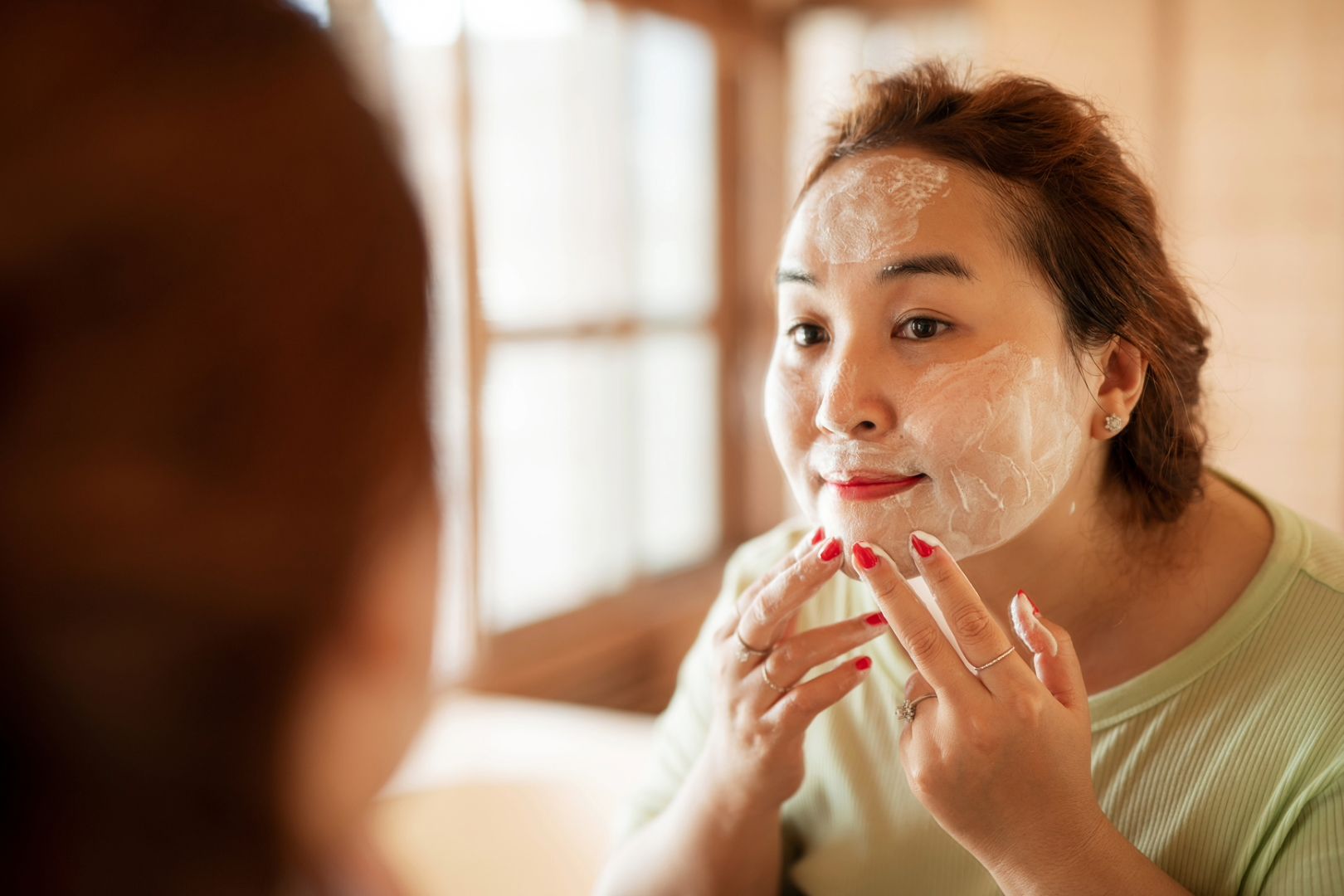If you’re experiencing redness, itching, or dryness, your skin might be trying to send you a message.
Whether you’re testing a couple of new skin care products or have been following a tried-and-true routine for some time and are now noticing irritation and redness, you may want to try a skin reset — a break from your usual skin care ritual. But are these mini-breaks all that helpful for allowing your skin to adjust, or is your skin irritation simply a sign that it’s time to swap out your skin care products for good? Here’s what experts have to say about the TikTok trend.
What Is a Skin Reset?
#SkinTok, TikTok’s popular world of all things skin care, has spawned tons of trends in the past few years (think skin cycling and skinimalism, just to name a few). One of the latest? Skin resets.
According to Fayne Frey, MD, a board-certified dermatologist, author of The Skincare Hoax: How You’re Being Tricked Into Buying Lotions, Potions & Wrinkle Cream, and founder of FryFace.com, there’s no medical evidence that our skin requires a reset (and there isn’t even one standard, single definition of the term, she adds), but people typically define a skin reset as a period of time when they stop using their skin care products “because they are experiencing mild irritation or redness, flaking, or itching,” Dr. Frey says.
Whether it’s because you’re overdoing it with too many products at once, mixing ingredients that don’t work well together, using a too-strong percentage of an ingredient for your skin, or you have a sensitivity or an allergy, your skin may react, says Merry Thornton, a board certified physician assistant in dermatology and founder of Element Medical Aesthetics in New Canaan, Connecticut. The result? Skin that gets more irritated by your daily routine, rather than less. In that case, you could benefit from what Thornton calls a “fast,” where you stop using all of your current skin care products, except for the essentials (such as sunscreen).
“Some patients find that when they scale back, less is more and they actually prefer their skin with just the basics.”
Though it’s not always easy to pinpoint which ingredient may be causing you issues, Thornton says that retinol (which often causes dryness), hydroquinone, exfoliating acids such as glycolic acid, benzoyl peroxide at a high percentage, vitamin C, and certain prescription products that are meant to be used short term are most commonly the main offenders.
Interested in learning more? Check out Anti-Aging Face Yoga
How Do You Reset Your Skin?
If the skin on your face is stressed and needs a breather, what should you do? It’s easy: Lay off your multistep routine. Instead, Thornton advises using a basic, gentle cleanser in the morning, followed by a moisturizing sunscreen (SPF 30 or higher, advises the American Academy of Dermatology). At night, use that same gentle cleanser plus a moisturizer. Keep things simple for as long as it takes for your skin to completely calm down, which she says can be anywhere from a few days to a few weeks.
If your skin stays irritated, red, or itchy for more than a few days after you stop using your products, or you have a severe allergic reaction or rash, speak with a dermatologist right away, Dr. Frey says. And if you’re using any facial products under a doctor’s care, check with them before stopping to do a skin reset.
When to End Your Skin Reset
There’s no timeline for ending your skin care hiatus. Even after your skin has chilled out, you may decide you’re happy with your new pared-down regimen. “Some patients find that when they scale back, less is more and they actually prefer their skin with just the basics,” Thornton says.
If, however, you miss the skin-pampering that masks, serums, and the like provide, Thornton says it’s a good idea to add them back in slowly, one at a time. Reintroducing one new product a week allows you to tease out what the ingredient is that might have bothered your skin. Another way to ease back in with your various lotions and potions is to use them less frequently — for example, only applying a pea-sized amount of retinol every other night rather than nightly.
Be aware that some common skin care ingredients “do not play nicely together,” Thornton says. For example, don’t mix retinol with vitamin C; retinol with alpha hydroxy acids; alpha hydroxy acids with vitamin C; hydroquinone with benzoyl peroxide; or retinol with benzoyl peroxide. Using these ingredients at the same time can either be too irritating or become less efficacious when combined.
For any new product you want to try out, or a product you want to reintroduce after a skin reset, it’s best to apply it to the back of your ear or on your forearm for a few days before applying it to your face. “Although this is no guarantee that a reaction on facial skin won’t occur, a sensitivity to a particular product or ingredient may become evident before use on facial skin,” Dr. Frey explains.
How to Find the Best Skin Care Routine for You
The best skin care routine for you depends on your budget and what your goals are. For example, if you would like to reduce the appearance of fine lines and uneven texture, that calls for different products than what someone who has acne-prone skin might use. Consulting an expert can help you figure out what belongs in your skin care routine and what ingredients to look for — and what to avoid. You can also pamper your skin in other ways, such as through face yoga, gua sha, and even some facial fitness trends.
Both experts agree that whatever products you do or don’t use, sunscreen is a must for everyone. “The single most important skin care product found in skin care aisles today is sunscreen,” Dr. Frey stresses. Using sunscreen daily on any skin not covered by clothing will help keep your skin looking its best and reduce your risk of skin cancer.
Keeping your skin well-hydrated helps it stay supple, smooth, and radiant, so the dermatologist says to look for water-based moisturizers formulated with glycerin, petrolatum, dimethicone, or other silicone derivatives.
Beyond that, Dr. Frey is a proponent of a less-is-more approach, which she points out saves you money as well as time. “The best skin care routine should be simple and affordable,” she says, adding, “There is no such thing as perfect skin. Skin will always have slight flaws and imperfections. Perhaps a change in our attitudes regarding beauty would be beneficial.” And because how you take care of your own body is reflected in your skin, Dr. Frey emphasizes the importance of exercising, eating a nutritious diet, and getting adequate sleep.
What’s the Difference Between Skin Cycling and a Skin Reset?
A skin reset is when you don’t use products with any exfoliating or deep-cleansing types of ingredients and stick solely to gentle moisturizers, sunscreens, and cleansers. Skin cycling, on the other hand, is a skin care regimen (made popular on #SkinTok, of course) where you cycle through four nights of different skin care products. For example, on night one, you apply a chemical exfoliant, such as one with glycolic or lactic acid; on night two, you use retinol; and on nights three and four, you use a night cream or lotion.
Once you’re done with your skin reset, following a skin cycling schedule can be beneficial, Thornton says. “We do not need to exfoliate daily. In fact, doing so can cause excessive dryness and irritation. Also, skin cycling makes sense when you want to use multiple active ingredients to target different skin concerns. It can be burdensome to apply layers and layers of products, and sometimes, products do not mix well or would be too irritating when used together. Alternating can cut down on irritation.”
Again, what your skin needs largely depends on your skin care goals. Not sure where to start? Thornton’s top five favorite skin care ingredients are vitamin C for brightening and protecting the skin; a zinc-based SPF (which is not absorbed by the body); hyaluronic acid for hydration; niacinamide to calm and reduce redness; and retinol to improve tone and texture and prevent fine lines.
The Bottom Line
It isn’t necessary to do a skin reset if you’re happy with how your skin looks and feels with your current routine. But if you’re experiencing redness, irritation, and flaking, then a temporary — or even permanent — reset may be in order.

